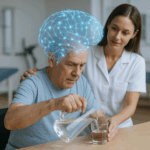Physiotherapy Treatment Protocol for Referred Pain from the Hip in Anterior Knee Pain
Overview of Conditions
Referred Pain from the Hip: The hip joint can refer pain to the anterior knee due to shared neural pathways and interconnected musculoskeletal structures. This condition is typically associated with dysfunction or pathology in the hip, such as osteoarthritis, hip impingement, or muscle imbalances, leading to knee pain. Referred pain from the hip is often misdiagnosed as primary knee pathologies like patellofemoral pain syndrome (PFPS) or patellar tendinopathy.
Etiology:
- Hip Osteoarthritis: Degenerative changes in the hip joint can alter biomechanics, leading to altered load distribution, which refers pain to the knee.
- Hip Muscle Imbalances: Weakness or tightness in hip muscles, especially the hip abductors, adductors, or flexors, can contribute to altered gait mechanics, leading to knee pain.
- Femoroacetabular Impingement (FAI): Abnormal contact between the femoral head and acetabulum can cause hip joint pain, which may radiate to the knee.
- Trochanteric Bursitis: Inflammation of the trochanteric bursa can refer pain to the knee, especially during activities like walking or climbing stairs.
- Lumbar Spine Pathology: Sometimes, hip-related referred pain can be secondary to lumbar spine issues, where nerve roots supplying the hip and knee are affected.
Assessment and Evaluation
History
- Pain Characteristics: Knee pain worsens with activities such as walking, squatting, or climbing stairs, without direct knee injury. The pain is often persistent and gradually increases over time.
- Onset: Onset may correlate with hip dysfunction, including a history of hip osteoarthritis, bursitis, or injury.
- Pain Referral Pattern: Pain may be felt around the anterior knee but is often associated with discomfort in the hip, groin, or lateral hip.
Physical Examination
- Inspection: Observe posture, gait, and lower extremity alignment. Asymmetry in hip rotation or tilt may be evident.
- Palpation: Assess for tenderness in the hip joint, iliotibial band (ITB), greater trochanter, and lumbar spine.
- Range of Motion (ROM): Assess hip flexion, extension, abduction, adduction, and internal/external rotation. Restrictions in these motions may suggest a hip pathology contributing to knee pain.
- Strength Testing: Evaluate the strength of hip abductors, adductors, flexors, and extensors. Weakness in these muscles can alter mechanics and contribute to knee pain.
Special Tests for Hip
- FABER Test (Flexion, Abduction, External Rotation): Positive for hip joint dysfunction.
- FADIR Test (Flexion, Adduction, Internal Rotation): Positive for femoroacetabular impingement (FAI).
- Trendelenburg Test: Positive if there is weakness in the hip abductors, which may lead to altered gait and knee pain.
Imaging
- X-rays: To evaluate the hip for osteoarthritis or femoroacetabular impingement.
- MRI: Provides detailed views of hip structures, assessing for soft tissue injuries or labral tears.
- Ultrasound: Useful for evaluating hip bursitis or soft tissue lesions.
Goal Setting
Short-Term Goals (0-4 weeks)
- Pain Reduction: Reduce knee and hip pain by 50% during functional activities (VAS ≤ 4).
- Improved Hip ROM: Restore normal hip mobility, particularly in flexion, abduction, and internal rotation.
- Muscle Activation: Begin strengthening exercises for hip musculature, especially gluteus medius and hip flexors.
- Posture and Gait Correction: Address any abnormal posture or gait contributing to knee pain.
Long-Term Goals (4-12 weeks)
- Full ROM: Achieve full, pain-free range of motion in the hip and knee joints.
- Strength and Stability: Restore strength and stability in the hip abductors, adductors, extensors, and core muscles.
- Pain-Free Function: Achieve pain-free function during high-demand activities, such as walking, running, or squatting.
- Prevention of Recurrence: Prevent future episodes of referred pain through a structured exercise program.
Recommended Treatment
Electrotherapy
- Transcutaneous Electrical Nerve Stimulation (TENS)
- Indication: Pain relief for both knee and hip.
- Parameters: Frequency: 80-120 Hz, Pulse Width: 100-300 µs, Duration: 20-30 minutes, 2-3 times/day.
- Mechanism: Blocks pain signals and provides analgesia during functional activities.
- Interferential Therapy (IFT)
- Indication: Pain and inflammation reduction in the hip and knee.
- Parameters: Frequency: 4,000 Hz modulated at 80-150 Hz, Duration: 20-30 minutes.
- Mechanism: Effective for deep tissue penetration, promoting blood flow, and tissue repair.
- Class 4 LASER Therapy
- Indication: Tissue healing in the hip and knee.
- Parameters: Wavelength: 800-900 nm, Power: 5-10 W, Duration: 5-10 minutes per area.
- Mechanism: Increases cellular metabolism and collagen production, reducing inflammation and promoting healing.
- Ultrasound Therapy
- Indication: Tissue healing for hip joint conditions like bursitis or strain.
- Parameters: Frequency: 1 MHz, Intensity: 1.0-1.5 W/cm², Duration: 8-10 minutes per area.
- Mechanism: Promotes collagen production and blood flow to accelerate healing in the hip and reduce knee pain.
Thermotherapy
- Moist Heat Packs
- Indication: Muscle relaxation around the hip and knee.
- Application: Apply heat for 15-20 minutes, particularly before stretching or exercises.
- Mechanism: Increases blood flow, reduces muscle tension, and facilitates improved flexibility.
Manual Therapy
- Soft Tissue Mobilization (Myofascial Release)
- Indication: Address tightness in the hip flexors, abductors, and iliotibial band (ITB).
- Technique: Gentle sustained pressure followed by stretching and mobilization.
- Mechanism: Improves tissue mobility, reducing stress on both the hip and knee joints.
- Joint Mobilization
- Indication: Restore normal joint mechanics in the hip.
- Technique: Gentle, controlled mobilizations to improve ROM and relieve pain.
- Mechanism: Increases synovial fluid distribution and reduces stiffness.
Exercise Therapy
- Hip and Core Strengthening
- Exercise: Strengthen hip abductors, adductors, and core muscles (e.g., clamshells).
- Duration: 3 sets of 10-15 reps, 2-3 times/week.
- Mechanism: Improves pelvic stability, reducing compensatory stress on the knee.
- Hip Mobility Exercises
- Exercise: Gentle stretches and dynamic movements (e.g., hip circles, lunges).
- Duration: 10-15 reps, 2-3 times/day.
- Mechanism: Restores hip function, reducing knee strain.
- Strengthening of Quadriceps and Hamstrings
- Exercise: Squats, leg presses, and other strengthening exercises for the knee.
- Duration: 3 sets of 10-15 reps, 2-3 times/week.
- Mechanism: Improves knee mechanics and reduces the impact of referred pain.
Precautions
- Avoid High-Impact Activities: Limit activities like running and jumping during the acute phase to prevent exacerbation of pain.
- Avoid Overstretching: Stretch gently during early rehab to avoid aggravating joint irritation.
- Pain Monitoring: If pain increases, reduce exercise intensity and focus on pain-free ranges.
- Progressive Loading: Gradually increase exercise intensity to allow the hip and knee to adapt without overloading tissues.
Reassessment and Criteria for Progression/Change in Care Plan
- Pain Levels: Progress when knee pain reduces to a VAS ≤ 3 during functional activities.
- Functional Improvements: Progress to higher-intensity exercises when pain-free during activities like squatting and stair climbing.
- ROM: Once full, pain-free ROM is achieved in the hip and knee, progress to dynamic exercises.
- Strength: Once hip strength returns to normal, transition to sport-specific rehab or return-to-play activities.
Disclaimer:
Disclaimer: This content is for informational purposes only. Always consult with a qualified healthcare provider for diagnosis and treatment recommendations tailored to individual needs.
References:
- Risberg, M. A., et al. (2023). “Rehabilitation for referred hip pain and its effect on knee pain: A systematic review.” Journal of Rehabilitation Research and Development, 60(3), 205-216. https://doi.org/10.1682/JRRD.2023.01.005
- Harris, A. L., et al. (2022). “Management of hip-related knee pain: A comprehensive guide.” Orthopedic Clinics of North America, 53(2), 277-289.






